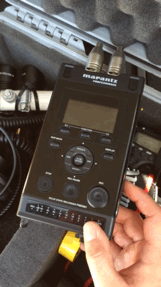I’m going to preface this blog post by mentioning that my field site, Elkhorn Slough, is home to over 100 sea otters. Elkhorn Slough is not a huge area, and that’s quite a few otters, so basically what I’m saying is that you can look in any direction and there’s a 90% chance you’re going to see an otter.
My first day of official data collection was last Friday. Needless to say, I was very excited to finally get out there and record some harbor seal vocalizations! I loaded up my kayak and headed about a mile into Elkhorn Slough.

That T-shaped PVC pipe towards the back of the kayak is what holds the hydrophones. It works like a pair of underwater ears: one hydrophone on the right and one hydrophone on the left to help the in-air listener roughly localize the underwater sound.
After positioning myself near one of the haul out sites and anchoring my kayak, I began assembling the recording apparatus. Parts of this apparatus, like the hydrophones and the PVC pipe, are designed to go underwater – that’s how we’re able to listen to underwater sounds. Other parts however, like the recorder and the batteries, need to stay dry. Like, really really dry. When paddling down the Slough, I keep these precious electronics stored in a reliably watertight Pelican case. Then, when I’m securely anchored, I take them out to begin data collection.
The hydrophones were underwater, my headphones were on, and I pressed record. The first recording of the season!! Data! Yay!
I didn’t hear anything. Hmmm time to trouble shoot….
Everything looked fine on my end, so I decided to pull up the hydrophones to see if something had gone awry. The next part of this story doesn’t sound real, but I swear to you that it did actually happen. As I pulled the PVC piece out of the water, AN OTTER REACHED UP AND GRABBED IT! Instinctually, I yanked the PVC pipe towards me, but given the hollow nature of PVC piping, this lead to an unfortunate influx of water into the kayak. Things got wet. The recorder got wet. The batteries got wet. Everything that wasn’t supposed to get wet, did.
I dried everything as best I could and headed back to the harbor for some further equipment triage. I’m not an expert when it comes to electronics, so I opted for the “take out the batteries and stick it in a bag of rice” trick. I decided to leave the recorder in the rice for 24 hours, just to be sure it was completely dry, and then I went back to the field on Sunday to see if my recorder was still alive.
I put in the batteries and flipped the power switch. Moment of truth…

This field season isn’t over yet! Time to get back out there (weather permitting) and attempt to make some more recordings. Just have to watch out for those otters…